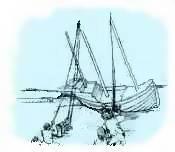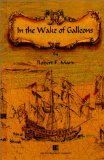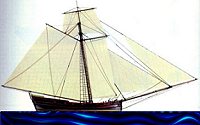The Pirate's Realm
Pirate ships could be almost any floating thing for pirates in the 17th and 18th centuries, but the most desirable pirate ships were swift, well-armed, and nimble enough to evade counterattack.
With the exception of certain ports in New England, there was no place to see a"pirate ship" already built and waiting for your custom Jolly Roger flag. Although some were previously paid for or later paid off, the best pirate ships were the ones most easily available.
Pirate Ship Tune (Win Media- 14Kb)
"Blow the Man Down" sequenced by Barry Taylor at contemplator.com (more info)
This usually meant stealing a ship or boat and customizing it: removing forecastles, upper structures, and cabins for extra speed, stripping interior bulk heads for more crew space and guns,

changing the mast and sail arrangement, and adding gun ports. Space was hard to come by on a pirate ship , because so many more men were needed both to fight with superior forces and to sail any vessel taken in battle.
, because so many more men were needed both to fight with superior forces and to sail any vessel taken in battle.
A ship could start off in great condition, but regular maintenance was vital to keep it shape. In some remote cove or river inlet, the vessel would be run aground in a way that would leave the hull exposed at low tide, prepared for careening. After pulling the ship over for optimum

exposure to the cleaning routine, it was scraped clean of all barnacles, weeds, mold, and any other extras which increased drag. Any planks were replaced which were too damaged from teredo worms, rot, battle wounds, or age, and the renewed hull was then coated with a layer of sulfur, tar, and tallow to help slow down any sea beasties which would destroy the ship.
Authorites would often wait to strike until the pirates were more vulnerable during the ship's careening, when their ship was out of water and their pants were around their knees.
Common Pirate Ships
Sloops- The favorite little wonder boat of Caribbean and Atlantic pirates in the late 1600's was first produced in large numbers by master builders in Jamaica, and her single-mast configuration was later changed by Bermudans in the 1700's. Although usually rigged for a larger fore-and-aft mainsail, it could easily be altered for various sail combinations. The huge bowsprit also added more canvas area for more maneuverability.
Thirty to sixty feet long with a top speed of over 10 knots, a crew of 20 to 70 men could easily work this father of the modern sailing yacht for lightning-swift attacks, avoiding broadsides, and outrunning pursuit. In spite of weighing as much as 100 tons and having perhaps 15 cannons, its draft was amazingly shallow at eight feet. This allowed it to find safety in shallower waters far beyond any warship's range.

A shallow draft was also was the reason that those entrusted to pursue pirate ships often favored the sloop to get access to their hiding spots. (more info)
Schooners- The two-masted schooner was another favorite of the Caribbean and Atlantic pirates. With many of the same features of the sloop such as terrific speed, maneuverability, and gun capacity, this swift American variant was first built in the 1700's with a narrower hull and a shallower draft of only 5 feet. This meant it could easily take a large haul and 75-man crew further inland to hide or to divide the booty, but a smaller hold stored fewer spoils. (more info)
Brigantines- This shallow-draft, two-mast brigand's ship gave terrific maneuverability and speed from its various square and fore/aft-rigged sail variations. It was prized in the Mediterranean, where its earlier versions sometimes included oars that were better for diminished winds. Heavier, longer, and roomier than the smaller sloops and schooners, it was usually first choice for prolonged battles instead of quick hits. Adequate firepower and a larger hold meant the versatile pirate ship also saw widespread use as a trade ship. 70-80 foot length, 125-150 tons, 100+ men, 12 guns... (more info)
Square-rigged Pirate Ships-
With their large square sails hanging from arms on the three masts, these would be rightly called ships, or merchant ships, for those outside of Naval use. Pirates knew merchant ships were fairly slow, full of valuable goods, and under-gunned because of skinflint owners. For crossing large bodies of water, a few versions may have been fairly swift for their size, but that size meant they were not agile - they could not turn on a dime...or a dollar. Owners and captains would try to compensate with more cannons, traveling in convoys, and military escorts.
Faster- The Merchant Carrier was a 275-ton, 80-foot- long variety with a more streamlined hull. It gained a reputation for rapidly ferrting passengers as well as cargo across the Atlantic in a month or less. The weak point was that such a large ship could usually have a small crew of 20 or less, and they could rarely fire more than a few of its possible 16 guns.
Fatter- The Dutch Fleut was so well-designed that it became the prototype for cargo carriers. This was a broad, flat-bottomed, and strong ship with a weight of 300 tons spread over only 80 feet. It could also carry 50 percent more cargo than other designs. Merchants on the tightest budget loved that the Fleut was inexpensive to build and to man, as only twelve men could make a crew. With the same weak defense as the carrier, there was no way for the crew to sail and fire very many of its twelve cannons.
Monster- An East Indiaman was by far the largest and best for long voyages. This titan was twice as large as a Fleut and weighed in at 700 tons! A pirate would spy this pregnant guppy on the horizon and get doubloon $igns in his eyes. The maximum pirate crew of 300 was probably possible only after successful runs in the Indian Ocean and the Red Sea, and the top gun capacity of 54 was often reduced to make room for more loot. (more info)
Galleons- These famous Spanish-designed trade and treasure ships rejected the light defense notion of other merchant vessels and were truly a force to be reckoned with. No amount of cannons, however, would deter the pirates attracted to the vast wealth they carried. With a crew over 200 on two or three decks of over 70 cannon, numerous swivel guns,

Predating the galleon, the Spanish and Portuguese sailed huge carracks on their trade routes. These three-masted ships were well-defended and large at over 1100 tons. A carrack could most always defend itself well against pirates. (more info)
Other Pirate Ships:
Galleys- The Barbary corsairs in the Mediterranean used a variant of this ancient, long and lean vessel during the 1500's and after. The sails provided only secondary power, because the main propusion was by up to 30 large oars rowed by several men apiece below the deck. One or more masts would attempt to take advantage of the occasional wind with lateen sails. Captains of the corsair galley first employed manpower to approach the prey, then if necessary, several cannon in the bow to assault, and finally on the large number of 100 or more marines or pirates to overcome the enemy.
Captain William Kidd sailed The Adventure Galley, made in England in 1695. Three masts of square sails, 46 oars, 34 guns, and a nearly 300-ton weight made it more like a frigate than a galley. (more info)
Junks- There really was no other real ship in the Far East but a junk for many centuries. Although the flat-bottom design was unimposisng, it was highly adaptable to merchant, military, and pirate demands alike.
Among its distinct features were its very high stern, flat bow, wide breadth, and adjustable rudder height. Chinese Junks could range in size from 45 to 100 feet and have two to four main masts, as well as several heavy guns. (more info)
-
27 Dec 2013 at 5:25pmimaginext, fisher price imaginext pirate ship as low as $19.99 (Reg. $59.99), kohls deals, kohls.com, retail deals, retail.
-
27 Dec 2013 at 12:30pmWow! Here's a sweet Kohl's.com deal for ya! Get the popular Fisher Price Imaginext Pirate Ship for just $14.39 (reg. $59.99!). Here's how: It's on sale for.
-
30 Dec 2013 at 9:59amIf we don't believe in freedom of expression for people we despise, we don't believe in it at all.
-
1 Nov 2012 at 10:00amAnchors Away Pirate Ship. Item Number: 628566. 2 years and up. Creative play and active play come together in this pirate-themed water table! Squirt water from the cannon, create currents with the spinner and splash away the day. Kids will ...
-
4 Nov 2013 at 1:37pmIt was a very rainy night, but enough kids braved the weather to make it all worth it. The pirate ship decor was huge success, we even got several par...







Aucun commentaire:
Enregistrer un commentaire